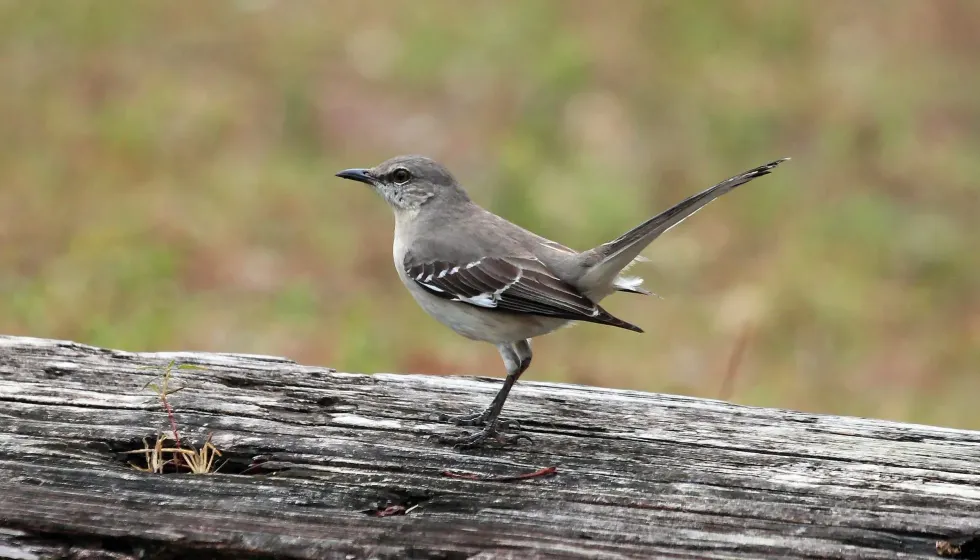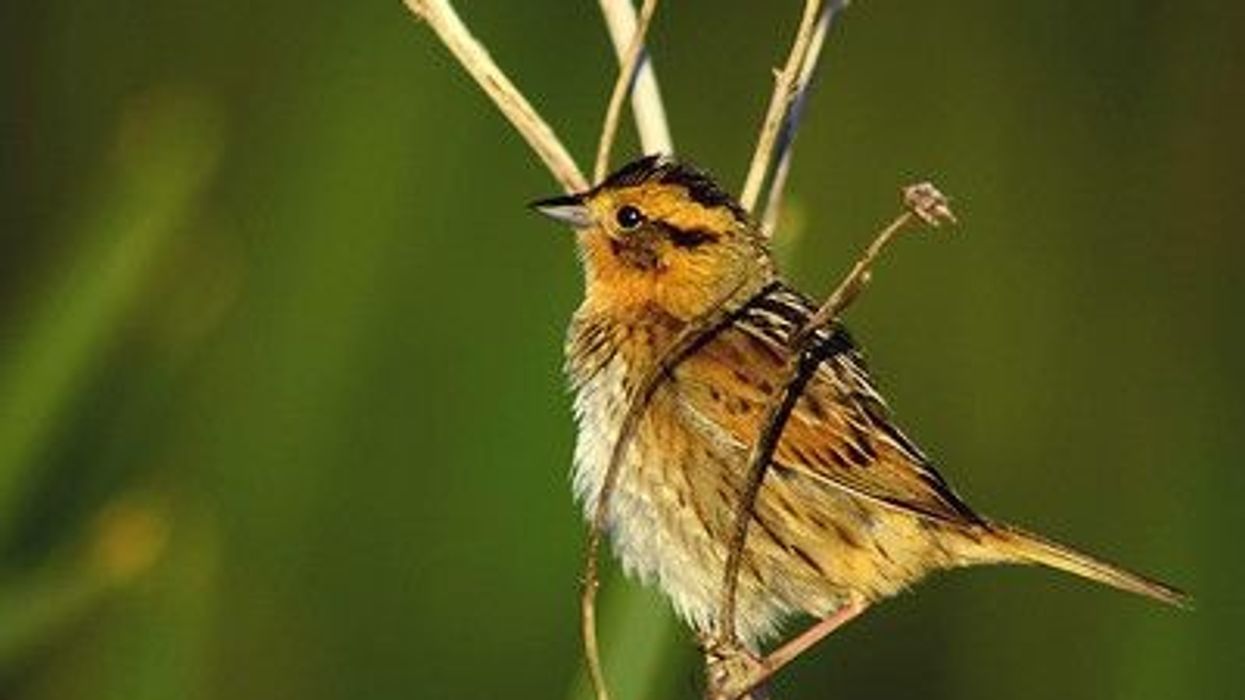The Florida grasshopper sparrow, Ammodramus savannarum floridanus, belongs to the Passeriformes order of animals. This is one of the only grasshopper sparrow species that has been marked as Endangered on the IUCN Red List.
This bird goes by the name of a grasshopper because of its insect-like vocal sounds. They have a brown, white, and grey body color just like the other sparrows with a few yellow streaks on their round head focusing near the eyes.
This bird species is mainly seen in the grass because they like to nest, run, and walk on the ground. The female bird is known to build a nest during the breeding period.
This nest has a cup shape and is covered with grass and hair. One interesting behavior of these birds is that they are okay with other females and birds entering their nests to help during this breeding period.
For more interesting information about other birds check out these Canyon Facts and Swamp Sparrow Facts.
Florida Grasshopper Sparrow Interesting Facts
What type of animal is a Florida grasshopper sparrow?
Florida grasshopper sparrow, Ammodramus savannarum floridanus, is a bird belonging to the Passerellidae family of animals.
What class of animal does a Florida grasshopper sparrow belong to?
These Florida grasshopper sparrows belong to the Aves class of animals.
How many Florida grasshopper sparrows are there in the world?
There were less than 80 Florida grasshopper sparrows recorded in the year 2019.
Where does a Florida grasshopper sparrow live?
This Florida grasshopper sparrow is found in the South and North American regions, especially in Florida.
What is a Florida grasshopper sparrow's habitat?
The Florida grasshopper sparrow habitat requires open grasslands and grass in a prairie habitat. They live in shrubs, pastures, and dry prairies with grass on the ground. They are sedentary and do not migrate. They follow a walking and running behavior rather than a flying one, especially while foraging for food.
Who do Florida grasshopper sparrows live with?
Even though these birds are monogamous during the breeding season, they do not live with their partner for a lifetime. They forage alone and do not live in a flock of their species.
How long does a Florida grasshopper sparrow live?
They have an average lifespan of 2.9 years in the wild. If not threatened by habitat fragmentation and with great conservation efforts, they might live up to 6 or 6.5 years too.
How do they reproduce?
Even though this subspecies of grasshopper sparrows are polygamous, they are considered monogamous during breeding. This means that the pairs stay together until the young are independent.
They might breed twice and lay up to two broods per year between April and August. Their nesting areas are focused on the ground, and the males fly to these areas early during the March-April months.
Males mark their territory on the ground and carry out certain behaviors to attract Florida grasshopper sparrow females. The male then attracts the female with their Florida grasshopper sparrow song.
They might also engage in a few wing-fluttering tricks. Once a female agrees and a pair is formed, they engage in a few bonding calls before building their nest and throughout the breeding period.
The Florida grasshopper sparrow female builds a nest on the ground, mainly in the prairie habitat or in tall grass areas. Their nests are cup-shaped, and they are covered with dried grass and hair.
A few biologists have observed non-breeding grasshopper sparrows visiting these nests. These non-breeding birds bring food for breeding pairs during this period.
The female then lays around three to six eggs in one brood. The incubation is done by mothers as well as the helpers for 10-13 days while the male protects the territory.
After hatching, the young ones are looked after by both the parents as well as the helping birds for 6-9 days. The babies, once ready, leave the nest by running out into their habitat settings rather than flying.
What is their conservation status?
This Florida grasshopper sparrow, Ammodramus savannarum floridanus, has been marked as Endangered under the Endangered Species Act (ESA) of 1973. This is mainly due to great amounts of habitat loss and other natural threats.
Florida Grasshopper Sparrow Fun Facts
What do Florida grasshopper sparrows look like?

These small birds have brown, tan, and white streaks on their wings. They have two yellow streaks on their round head near the eyes. Their underparts are white or cream and the young ones have striped breasts. They have a long bill and a short tail, unlike other grasshopper sparrow subspecies.
How cute are they?
Florida grasshopper sparrows have a sweet sound and are tiny in size, making them look too cute.
How do they communicate?
This grasshopper sparrow engages in vocal communication. Male birds are seen doing this mainly during the breeding season with their songs.
They also have a few calls, like the high-pitched sound of "seet" that they use as a bonding call and a ‘tiddick’ sound that they use as an alarm call. The male birds also use visuals like the wing-fluttering trick to attract females.
How big is a Florida grasshopper sparrow?
This Florida grasshopper sparrow is twice the size of a bee hummingbird with a length of 4.3-4.5 in (10.8-11.5 cm) and a wingspan of 7.9 in (20 cm).
How fast can a Florida grasshopper sparrow fly?
It is said that this bird species likes to walk and run on the ground rather than fly. Even then, they can fly with an average sparrow flight speed of 20-30 mph (32-48 kph).
How much does a Florida grasshopper sparrow weigh?
This small sparrow breed has a weight range of 0.5-0.7 oz (14-20 g).
What are the male and female names of the species?
No, Florida grasshopper sparrow is a sex-neutral term used for both males and females.
What would you call a baby Florida grasshopper sparrow?
Baby grasshopper sparrows are called chicks.
What do they eat?
This bird has an omnivorous diet consisting of spiders, caterpillars, beetles, small bugs, and a few grains and seeds as their food supplies.
Are they dangerous?
No, they are not dangerous.
Would they make a good pet?
This bird population is said to be endangered due to habitat loss. Hence, most organizations like the white oak conserve them. Although, keeping them as personal pets is not advised.
Did you know...
Grasshopper sparrows got their name because of the buzz, or the insect-like sound, they use for their different calls. These birds, even though the species, on the whole, is considered to be of Least Concern, the Florida grasshopper sparrow has reached near extinction and is highly endangered with a population of fewer than 80 birds.
The Florida grasshopper sparrow's song
Male Florida grasshoppers use their songs mainly to attract females. The songs have the notes of ‘tick tick pzzz’. This bird species make insect-like ‘tiddick’ and ‘seet’ sound as their alarm and bonding calls respectively.
Why is the Florida grasshopper sparrow endangered?
Florida grasshopper sparrows are facing a population decline mainly because of the loss of their habitat. Human development has led to the increased conversion of prairies into agricultural lands and pastures. This has reduced the open ground space, and easy availability of grass, and shrubs which are the major habitat requirements for this bird.
Here at Kidadl, we have carefully created lots of interesting family-friendly animal facts for everyone to discover! For more relatable content, check out Myna Facts and Blue Tit Facts.
You can even occupy yourself at home by drawing one on our Florida Grasshopper Sparrow coloring pages.










